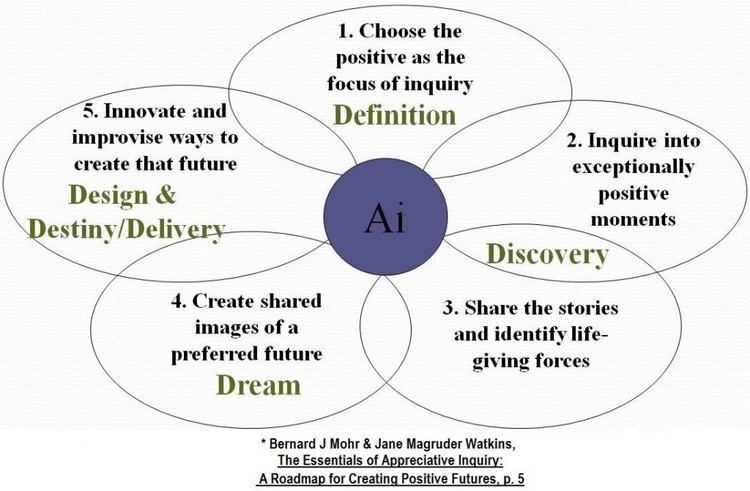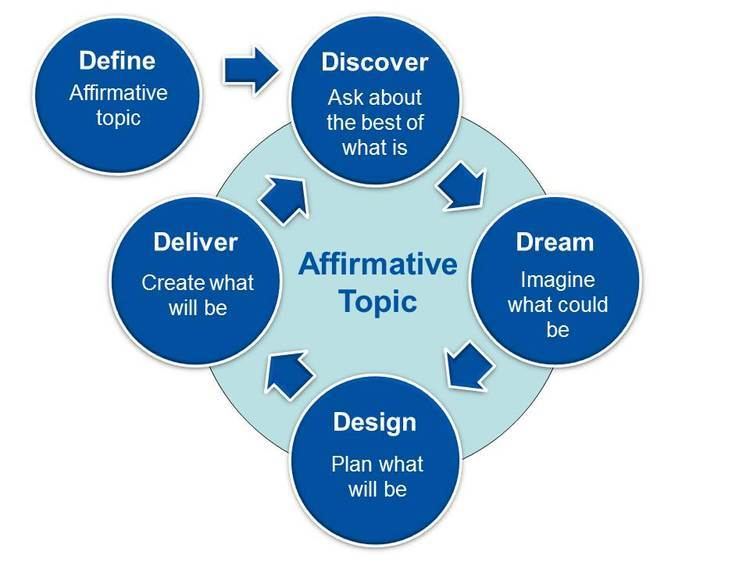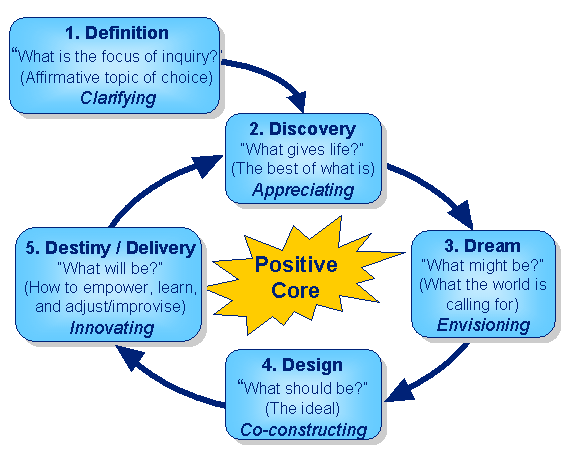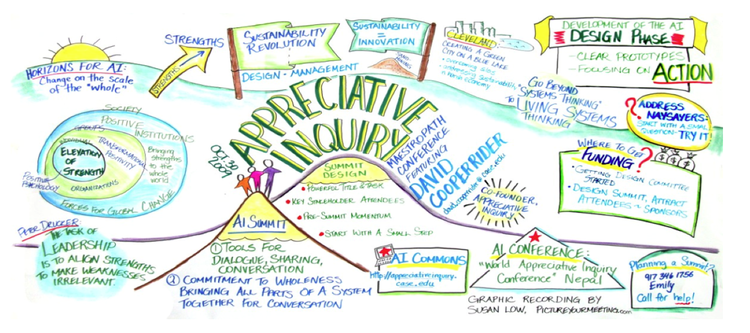 | ||
Appreciative inquiry
Appreciative inquiry (AI) is a model that seeks to engage stakeholders in self-determined change. According to Bushe "AI revolutionized the field of organization development and was a precursor to the rise of positive organization studies and the strengths based movement in American management." It was developed at Case Western Reserve University's department of organizational behavior, starting with a 1987 article by David Cooperrider and Suresh Srivastva. They felt that the overuse of "problem solving" hampered any kind of social improvement, and what was needed were new methods of inquiry that would help generate new ideas and models for how to organize.
Contents
- Appreciative inquiry
- What is appreciative inquiry mov
- History
- Basis and principles
- Distinguishing features
- Appreciative Inquiry Quality Improvement and SOAR
- Implementing AI
- Uses
- References

What is appreciative inquiry mov
History

Cooperrider and Srivastva took a social constructionist approach, arguing that organizations are created, maintained and changed by conversations, and claiming that methods of organizing were only limited by people's imaginations and the agreements among them.
In 2001, Cooperrider and Diana Whitney published an article outlining the five principles of AI.

In 1996, Cooperrider, Whitney and several of their colleagues became centrally involved using AI to mid-wife the creation of the United Religions Initiative (www.uri.org), a global organization dedicated to promoting grassroots interfaith cooperation for peace, justice and healing. This early and partnership between URI and AI is chronicled in Birth of a Global Community: Appreciative Inquiry in Action by Charles Gibbs and Sally Mahé. AI was also used in the first (1999) and subsequent meetings of business leaders that created the UN's Global Compact. In another of the early applications, Cooperrider and Whitney taught AI to employees of GTE (now part of Verizon resulting in improvements in employees' support for GTE's business direction and. as a part of continuous process improvement generated both improvements in revenue collection and cost savings earning GTE an ASTD award for the best organisational change program in the US in 1997."
On May 8, 2010, Suresh Srivastva died.

Gervase Bushe, a researcher on the topic, published a 2011 review of the model, including its processes, critiques, and evidence. He also published a history of the model in 2012.
Basis and principles

According to Bushe, AI "advocates collective inquiry into the best of what is, in order to imagine what could be, followed by collective design of a desired future state that is compelling and thus, does not require the use of incentives, coercion or persuasion for planned change to occur."

The model is based on the assumption that the questions we ask will tend to focus our attention in a particular direction, that organizations evolve in the direction of the questions they most persistently and passionately ask. In the mid 80's most methods of assessing and evaluating a situation and then proposing solutions were based on a deficiency model, predominantly asking questions such as "What are the problems?", "What's wrong?" or "What needs to be fixed?". Instead of asking "What's the problem?", others couched the question in terms of "challenges", which still focused on deficiency, on what needs to be fixed or solved. Appreciative Inquiry was the first serious managerial method to refocus attention on what works, the positive core, and on what people really care about. Today, these ways of approaching organizational change are common
The five principles of AI are:
- The constructionist principle proposes that what we believe to be true determines what we do, and thought and action emerge from relationships. Through the language and discourse of day to day interactions, people co-construct the organizations they inhabit. The purpose of inquiry is to stimulate new ideas, stories and images that generate new possibilities for action.
- The principle of simultaneity proposes that as we inquire into human systems we change them and the seeds of change, the things people think and talk about, what they discover and learn, are implicit in the very first questions asked. Questions are never neutral, they are fateful, and social systems move in the direction of the questions they most persistently and passionately discuss.
- The poetic principle proposes that organizational life is expressed in the stories people tell each other every day, and the story of the organization is constantly being co-authored. The words and topics chosen for inquiry have an impact far beyond just the words themselves. They invoke sentiments, understandings, and worlds of meaning. In all phases of the inquiry effort is put into using words that point to, enliven and inspire the best in people.
- The anticipatory principle posits that what we do today is guided by our image of the future. Human systems are forever projecting ahead of themselves a horizon of expectation that brings the future powerfully into the present as a mobilizing agent. Appreciative inquiry uses artful creation of positive imagery on a collective basis to refashion anticipatory reality.
- The positive principle proposes that momentum and sustainable change requires positive affect and social bonding. Sentiments like hope, excitement, inspiration, camaraderie and joy increase creativity, openness to new ideas and people, and cognitive flexibility. They also promote the strong connections and relationships between people, particularly between groups in conflict, required for collective inquiry and change.
Some researchers believe that excessive focus on dysfunctions can actually cause them to become worse or fail to become better. By contrast, AI argues, when all members of an organization are motivated to understand and value the most favourable features of its culture, it can make rapid improvements.
Strength-based methods are used in the creation of organizational development strategy and implementation of organizational effectiveness tactics. The appreciative mode of inquiry often relies on interviews to qualitatively understand the organization's potential strengths by looking at an organization's experience and its potential; the objective is to elucidate the assets and personal motivations that are its strengths.
Bushe has argued that mainstream proponents of AI focus too much attention on "the positive" and not enough on the transformation that AI can bring about through generating new ideas and the will to act on them. In a 2010 comparative study in a school district he found that even in cases where no change occurred participants were highly positive during the AI process. What distinguished those sites that experienced transformational changes was the creation of new ideas that gave people new ways to address old problems. He argues that for transformational change to occur, AI must address problems that concern people enough to want to change. However, AI addresses them not through problem-solving, but through generative images. Some of this is covered in a 90-minute discussion about AI, positivity and generativity by Bushe and Dr. Ron Fry of Case Western, at the 2012 World Appreciative Inquiry Conference.
Distinguishing features
The following table comes from the Cooperrider and Whitney (2001) article and is used to describe some of the distinctions between AI and approaches to organizational development not based on what they call positive potential:
Appreciative inquiry attempts to use ways of asking questions and envisioning the future in order to foster positive relationships and build on the present potential of a given person, organization or situation. The most common model utilizes a cycle of four processes, which focus on what it calls:
- DISCOVER: The identification of organizational processes that work well.
- DREAM: The envisioning of processes that would work well in the future.
- DESIGN: Planning and prioritizing processes that would work well.
- DESTINY (or DEPLOY): The implementation (execution) of the proposed design.
The aim is to build – or rebuild – organizations around what works, rather than trying to fix what doesn't. AI practitioners try to convey this approach as the opposite of problem solving.
Appreciative Inquiry, Quality Improvement, and SOAR
Operational strategic plans are sometimes generated with the best intents, only to be forgotten and put on a shelf and reexamined only when performance reviews are taking place. Operational strategic plans need to be flexible enough to meet the needs of changing environments. The SOAR strategic plan should be reviewed on a regular basis and adjusted to guarantee that it endures to meet the needs of the organization. Soar techniques help to provide specific applications of AI principles, helping organizations with an enhanced framework for operational strategic planning. Using SOAR within the strategic operations planning process allows organizations construct their pathway to success. SOAR analysis is one of the most important aspects of the strategic planning process for any organization (McKenna, Daykin, Mohr, & Silbert, 2007).
Our Operations group is good at identifying stakeholders who participate in planning meetings. These stakeholders represent all levels and functional levels within the organization, as well as creating an interview questionnaire to find and categorize employee and stake holder strong point, perceptions and aspirations.
The Operations group engages employees and stakeholders, which includes clients, vendors, and partners, if appropriate. This helps the Operations group to realize the conditions that created the organization’s greatest successes, while ignoring threats, weaknesses and/or problems. The discussions need to focus on what do we want, and not on what we don’t want, while inspiring.
Our operations group could improve its function ability processes by assessing and improving systems. By building and implementing management systems, by establishing sustainable continuous improvement processes, by implementing lean business practices, and by establishing process and correlating business result metrics and “dashboards”, as well as building and measuring customer and employee loyalty.
SOAR takes the Appreciative Inquiry philosophy and applies it to provide a strategic thinking and dialog process. By using, SOAR (strengths, opportunities, aspirations, results) and AI (Appreciative Inquiry) will help guide our operations group through planning in a manner that is both results oriented and co-constructive at the same time. Appreciative Inquiry and SOAR approaches to strategy development lend tremendous potential for success, essentiality keeping our Operations group positive and participative (Kessler, 2013).
References
Kessler, E. H. (2013). Encyclopedia of Management Theory: The Appreciative Inquiry Model. Thousand Oaks, CA: Sage Publications.
McKenna, C., Daykin, J., Mohr, B. J., & Silbert, T. (2007). Strategic Planning with Appreciative Inquiry: Unleashing the Positive Potential to SOAR. Retrieved from http://innovationpartners.com
Implementing AI
There are a variety of approaches to implementing appreciative inquiry, including mass-mobilised interviews and a large, diverse gathering called an Appreciative Inquiry Summit. These approaches involve bringing large, diverse groups of people together to study and build upon the best in an organization or community.
Current resources on AI include(in alphabetical order):
Uses
AI is used in organizational development and as a consultancy tool in an attempt to bring about strategic change. It has been applied in businesses, health care bodies, social non-profit organizations, educational institutions, and government operations. Although originating in the US, it is also used in the UK – for example in the National Support Teams and around the world. Since 2000, The AI Practitioner, a quarterly publication, has described applications in a variety of settings around the world.
AI has various business applications and can effectively be used to elicit information from stakeholders. Positivity is paired with a group consensus to envision and begin producing an optimistic future based on existing strengths and successes. As seen in Harbarian process modeling, AI has been used in Business process modeling to elicit information about an organization's present state and desired future state.
In Vancouver, AI is being used by the Dalai Lama Center for Peace and Education. The Center, which was founded by the Dalai Lama and Victor Chan, is using AI to facilitate compassionate communities.
